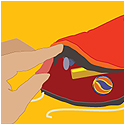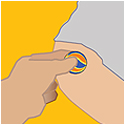


Experiment Category:
Objective:
Participants will learn about their senses as they explore using their sense of touch.
What You Need:
- Cloth bags (one for each pair of participants)
- Objects for identification (these can be anything you like; objects that can be confused add to the fun of the activity)
- A partner
To Do and Observe:
1. Place all objects into the bag. Only one partner should know what the objects are.
2. Have your partner close her eyes, reach into the bag and pick an object.. She should try to identify the object using only her sense of touch, without looking into the bag or pulling the object out of the bag. Ask your partner to describe the object to you as she tries to figure out what it is.
3. Once your partner has guessed what the object is, have her pull the item out the bag and open her eyes. Did she guess correctly? What properties of the object was she able to recognize using her sense of touch? What properties was she unable to recognize with touch only?
4. Have your partner roll up her sleeve and close her eyes. Select an object from the bag and place it against you partner’s upper forearm.
5. Ask your partner to try to identify the object. Ask your partner to make observations based on what she feels on her arm. Guessing the object is difficult – to help you partner ask questions about what she feels: is the object hard? Soft? Does it feel smooth? If not, what is the texture? Does it have sharp edges?
6. Repeat step 5, but this time touch the object to your partners fingertips, instead of her forearm. Is there any difference in what she can feel using her fingertips versus her forearm?
7. Reveal the object to your partner. Now switch roles and repeat the experiment.
What's Going On:
The skin is the largest sensory organ of the body. The skin is sensitive to many different kinds of "stimuli", such as pressure and temperature. Within the skin, there are different types of "receptors" that are activated by different stimuli. When a receptor is activated, it triggers a series of nerve impulses. For a person to "feel" the stimulus, the nerve impulses must make their way up to brain.
The receptors in our skin are not distributed in a uniform was around our body. Some places, like our fingers and lips, have many more touch receptors that other parts of our body, like our back or our forearms. That’s one reason why we are more sensitive to touch on our fingers and face than other places on our body. There are certain diseases that can affect your sense of touch. Individuals that have ADD, Attention Deficit Disorder, can be much more sensitive to touch than other people. Individuals that suffer from diabetes can be less sensitive to touch than others.
Parent/Teacher Tips:
For Younger Participants
Have the participants close their eyes and pick up different materials, such as sandpaper, soft cotton, paper, etc. Using only their fingertips participants should be able to determine the different type materials. Can they do the same if someone was to rub the material on the backs of their hands or forearms?
To reinforce the idea that different parts of your body can feel things differently, older participants can try this: Bend a paper clip in a U-shape with the tips about 2 cm apart; make sure that the tips are even with each other. Working in pairs, one partner hold the paper clip and the other close his eyes with hand outstretched, palm down. One partner lightly touch the two ends of the paper clip to the back of the other partner’s hand. Try not to press too hard! Make sure that both tips touch the skin at the same time. Ask the other partner if how many pressure point he feels. Try this 5 times – alternating at random between touching the partner with one or two points. Now repeat the test on other parts of your partner’s body (avoid the eyes!) including the palm of his hand. Which parts of the body are most sensitive to touch? Why do you think this is so?
